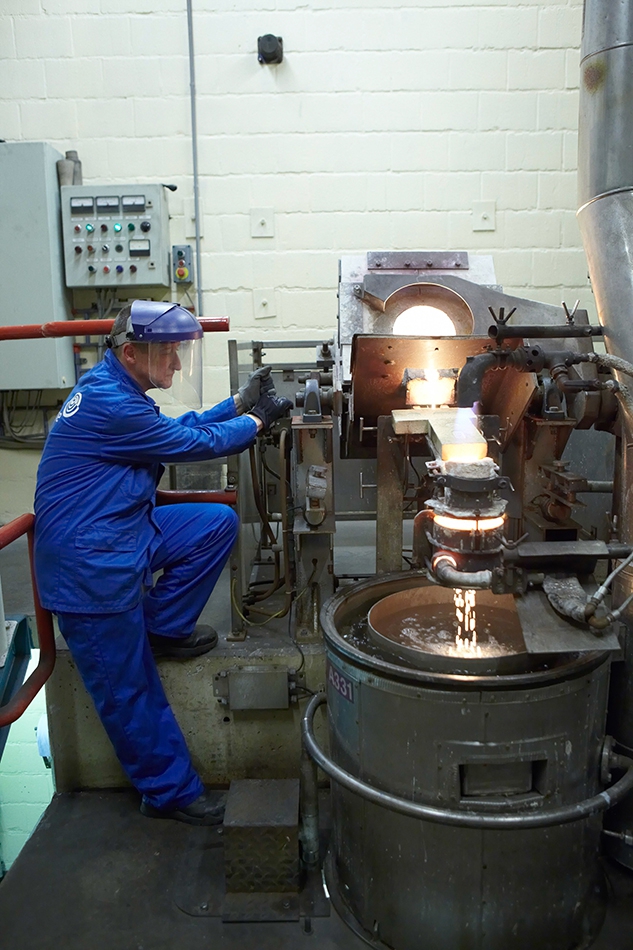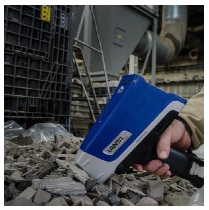SAMPLING, REFINING & CO🧪
POSTED BY ALICE
The recycling supply chain for used catalytic converters involves a number of stages, from their removal from end-of-life vehicles through to the extraction of the valuable precious metals. There are, though, two main players in the process – “samplers” and “smelters” (refining companies).

Sampling companies
Sampling companies are organizations that take a sample of a certain quantity of catalytic converters. Their goal is to assess the precious metal content inside a batch of used catalysts, usually through the use of X-ray fluorescence technologies.
“This is an XRF Handheld from Brucker”
The Problem of Separation
There are two types of catalysts, Diesel Particle Filters (DPF) and Catalytic Converters (CCC). Their composition differs, with DPF made of Silicon Carbide and Catalytic Converters of Ceramic. Since their composition isn’t the same, their fusion degree is also different – as the saying goes, you cannot mix apples and oranges!
With a mixed batch of catalysts, sampling companies usually provide a better service as they are in regular contact with a large number of refiners and will divide any batch within their network to ensure the best metal return rate and best offers.
De-canning
De-canning is the process of separating the honeycomb (where all the PGMs are contained) from its metal shell, and it requires specific shearing machinery. The most common types are “guillotines” and “alligator” shearers. The process can be dangerous for the operator and needs to be carried out under proper supervision.
If unsure of what to do, and to avoid injury, it is better to let a professional do it. Sampling companies can offer a de-canning service for used catalysts, either at a fixed charge or possibly for free depending on the negotiation or the scope of their offers.
“Shearing machine – Guillotine”
The Obstacle of Technology
When a certain quantity of metal is smelted in a furnace, its mass will shrink and thus provide a higher concentration of the precious metals. Leftover, though, is a quantity of metal known as “slag” that will still contain a small amount of PGMs and needs to be retreated, thus increasing costs.
Sampling companies usually use plasma furnaces that are much more efficient than traditional furnaces and that will reduce by a hundred-fold the total volume of a batch, thus making it purer for the PGMs.
Some companies, for example, such as Johnson Matthey, have a weak recycling power because their core activity is the recovery of PGMs, and so they are only interested in the purest precious metals products and avoid as much as possible dealing with metal slags.
Using companies who possess the correct type of technology will thus allow catalyst sellers to deal with the most efficient, prominent smelters.
Smelters
Smelters are the “real” refiners, melting metals to separate the alloy from its impurities, in order to recover the actual precious metals.
They will usually buy a “bullion” (a concentrated alloy of PGMs already reduced by the plasma furnaces of sampling companies) or they will treat and smelt ceramic powder. They may also smelt together with other metals.
How smelting companies are working
Usually, when it comes to old scrap, smelters tend to recycle all of it without making any separation (silicon carbide/ceramic / PCB…). They are also difficult to negotiate with since they already possess a huge captive market and have significant financial muscle. Thus, sometimes they refuse to pay for some metals that are recycled. Furthermore, they often don’t offer competitive prices because they might not have needed the metals being offered.
Smelting companies are the final actor in the PGM recycling process. They only treat fully de-canned catalytic converters and if only a small quantity of catalyst is offered, they may refuse to accept or else give very uncompetitive rates. However, sampling companies can send them material from a number of suppliers thus making the quantity a viable amount. It should be remembered, as we demonstrated in our market sizing study, that PGMs does not only come from the car industry – old jewelry and electrical scrap are also important players in the PGM recycling market.
Difference between Samplers and Smelters
In a way, it can be said that Smelters are like big furnaces whilst sampling companies are PGM recycling wholesalers.
The main difference between them resides in their position in the process chain and in the extras services they offer. An Organization that already possesses the necessary treatment skills and technologies in-house (including de-canning) and collects a significant volume of material (usually more than 20 metric tons) can go directly to a smelter to handle its refining. Otherwise, it is likely to be more profitable to work with sampling companies who have greater negotiating power with the smelters.

























